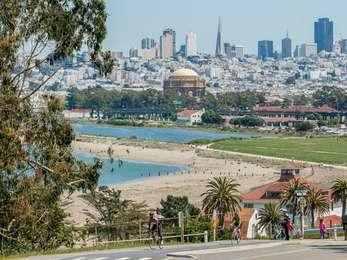Last updated: March 3, 2021
Place
11 - "Sand" Francisco

WAYSIDE PANEL TITLE: "Sand" Francisco
PANEL DESCRIPTION: Graphic panel set in metal frame. The wayside faces north, on the northern side of the trail.
VIEW FROM WAYSIDE: This panel stands along the bayside of the San Francisco Bay Trail. Directly in front of you is a fenced off section of dunes, mostly covered in dark green coastal scrub plants. Further out are the waters of the bay and the Marin Headlands. To the north west, you can see the Golden Gate Bridge.
TEXT: These revitalized coastal dunes are a small remnant of an extensive ecosystem that once covered about one-third of the area that is now San Francisco. The sandy soil sustained a mosaic of native grasses, wildflowers, shrubs and oak trees adapted to a climate of mild, wet winters and summer drought. This coastal dune scrub community supported a diversity of animals from insects to grizzly bears. The transformation to cityscape has been devastating to both the dune habitat and its native wildlife.
DESCRIPTION OF IMAGE: Thick plant cover on a white sand dune. The plants are low to the ground, with yellow and pink blossoms. Their tendrils spread over the sand, extending their reach across the dune.
CAPTION: Adapted to desert-like conditions of low nutrients, high winds and extreme water loss, native plants stabilize the dunes. Growing in a patchwork, the plants capture moving sand and their lengthening root systems help hold the sand in place.
TEXT: "CPR" for Dunes. The development and use of Crissy Field destroyed its natural dunes and decimated its native plant communities. Ecological restoration of the native dune system here has included the reintroduction of native plants grown in park nurseries and planted by park volunteers. A generous grant from the California Coastal Conservancy helped fund this project, and sustained CPR--community-based preservation and restoration--will assure long-term protection and care for these improvements.
DESCRIPTION OF IMAGE: A young woman and boy crouching on bare soil, facing each other. They're wearing work gloves, and the woman has a baseball cap on that's shading her face from the sun. They're both holding onto a small plant with long, thin tendrils above a small dug out hole in the soil. Behind them are more people crouching in the dirt, which extends far into the distance.
CAPTION: Thousands of volunteers helped restore Crissy Field. They removed countless invasive exotic plants and placed more than 100,000 native plants in the ground to help the ecosystem get established.
DESCRIPTION OF IMAGE: Illustration of a plant with a white blossom with six petals around a light-yellow center. Its green leaves grow in threes and are rounded except for the front edge which is serrated. It grows along a pinkish-red vine.
CAPTION: Beach strawberry spreads rapidly by runners and forms dense mats that stabilize the soil. Its waxy leaves retard water loss.
DESCRIPTION OF IMAGE: Illustration shows a plant that also grows on a vine, but has a more vertical structure to its blossom. The blossom is pink and round like a sphere, the petals growing in more of a three-dimensional pattern. The green triangle-shaped leaves with rounded edges grow above and below the flower.
CAPTION: The pink sand verbena's sticky succulent stems store water and trap windblown sand. Sand buildup stimulates the continued growth of this mat-forming perennial.
DESCRIPTION OF IMAGE: Illustration shows a vertical plant with five small, round blue blossoms at the top of its stalk. Lower down on the stalk are five crinkly looking leaves, and at the very bottom, a dense section of smaller leaves growing close together.
CAPTION: Silky hairs on the silver bush lupine's leaves reflect heat and protect them from drying out. Capable of fixing nitrogen from the air, an advantage in nutrient-poor sand, these plants can live many decades.
DESCRIPTION OF IMAGE: Illustration is of a plant with a long stalk with small round blossoms growing on both sides all the way to the tip, which is bent slightly to the right. At the plant's base are green, serrated leaves and spiky, yellow blossoms growing at intervals along the center of the stalk.
CAPTION: The thick roots of the beach bur stabilize the sand that builds up around the fast-growing stems. Its seeds have spines that resist movement in the shifting sand and enable the seeds to take root.
DIRECTIONS TO NEXT STOP: Walk west a little over one tenth of a mile and you'll arrive at the next wayside on the southern side of the trail.
